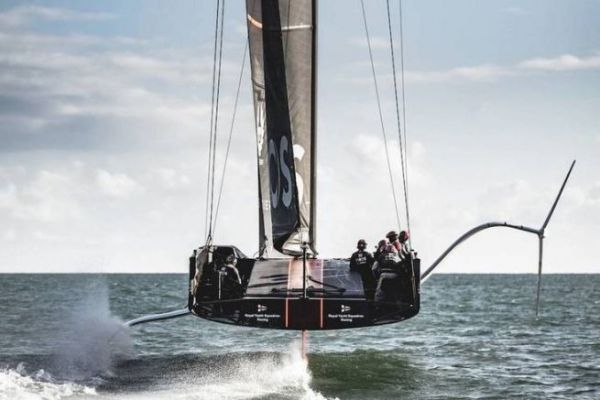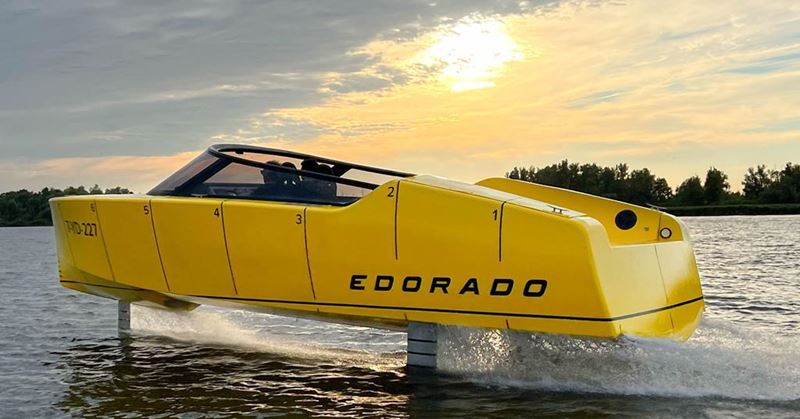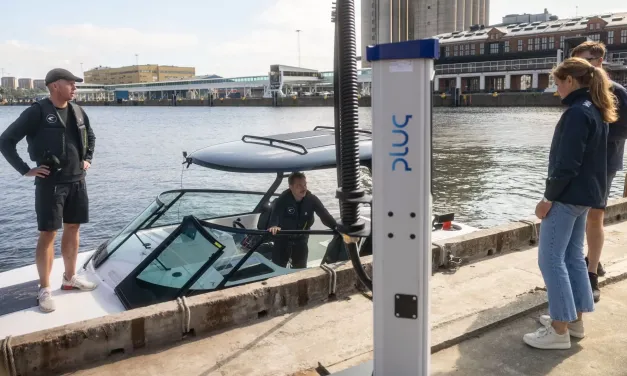Rapid development of technology and infrastructure may propel electric propulsion to become the new standard in boating and yachting. Fast charging stations and improvement of efficiency in the drive train, together with advanced control of hydrofoils, can enable battery powered boats to achieve range and speed comparable at comparable or even better figures than fossil fuelled boats. A glance at recent innovations reveals the potential for exhaust free waterborne transport.
Range and speed have been the bottleneck of electric propulsion in the last decade that has seen the introduction of market ready solutions for this battery powered boats. In the wake of electric mobility over land, manufacturers of yachts, motorboats and their electric propulsion systems develop new equipment to improve the ease of use, the range, and the comfort of the experience on the water aboard your zero emission boat. Breakthrough innovations could extend the range of batteries, while significantly improving on their safety and durability – see the article on battery development also in this newsletter.
Hydrofoil frontier
Hydrofoils multiply sailing speeds. They also offer fast rides aboard electric motorboats with gratifying range. The technological forefront of hydrofoil speed sailing is undoubtedly the America’s Cup. From the first time the New Zealand AC catamaran Aotearoa was seen foiling in 2012, a significant battle in the world’s most prestigious sailing race has been mastering foil control. Surface piercing hydrofoils are designed to automatically control the height. These types of foils also show the wing profile of an aeroplane, but they are mounted diagonally, or they come curved or in a V-shape. When the hull is floating in the water, the hydrofoils are completely submerged. All of the profile is underwater. When the boat starts moving, the whole of the wing profile will start generating lift. At a certain speed, this force will become enough to lift the hull out of the water. When the speed and the lift generated increase, the hull sails higher above the water. But with the foils mounted diagonally, curved or in a V-shape, less of the foil profile will be in the water. With less profile surface, the lifting power also decreases. With this simple principle, the height of the vessel above the waves is automatically regulated.

Fully submerged hydrofoils have the shape of an aeroplane wing, connected to a vertical beam attached to the boat hull. These foils cause the least drag, as only a very narrow profile moves through the water surface. Therefore, boat designers seeking for maximal range and propulsion efficiency favour this type. Fully submerged foils require height control to maximise lift before getting the hull out of the water and reducing the lift with increasing speeds. The Inertial Measurement Unit (IMU) technology that is used in drones and aviation autopilots is also used to control submerged foils.
Ride control
Hydrofoils are applied to get electric boats to cover long ranges at high speed and today, technology to improve the control of the lifting forces from these underwater foils is refined. Computers constantly monitor the speed, the height above the water, the forces that occur when turning the boat and control the foil position to provide the most efficient lift at any moment.
- The Icon from German boatbuilder Tyde Yachts is a passenger tender that uses technology derived from flying drones to control the lifting power from its hydrofoils for a smooth ride, even in curves. The board computer calculates the best position of the foil flaps for the most effective and comfortable fly height.
- The flight control system on the foiling yachts from Swedish yard Candela uses a variety of sensors to estimate the position, velocity, and acceleration of the boat on all axes. It combines data from more than 10 sensors, to estimate the true state of the system at all times.
- Enata, a brand from the United Arab Emirates, presented the foiling yacht Vatoz this month. This uses the yards’ Wingman technology that enables the boat to fly at 5 feet (1.52 m) above the water. The foils on this yacht retract and fold along the hull at low speeds, to take away the appendages pointing out from the hull while docking or at anchor.
- Dutch yard Edorado uses retractable hydrofoils to control the bow lift and stability. Their Edorado 8S is nominated for European Powerboat of the Year 2024.

Fast Charging
Fast charging stations that source their own electricity from fuel cells or solar power could form a network along boating routes to create independence from the land based electricity grid. These stand-alone charging stations may provide an operational network in a much faster pace than would be possible with upgrading the land based electricity network to provide the charging capacity needed.
- Nortvolt Voltpack contains a battery that slowly charges itself when connected to a source of electric energy. This can be a normal land grid connection or a set of solar panels or even a small wind turbine. The charged battery can boost the energy flow when charging the battery of a vehicle, be it a boat or a car.
- Aqua Super Power has developed fast chargers for boats and is installing them along the Swedish west coast in an effort to provide a network from Gotheborg to Oslo for electric boaters without range anxiety.
- Plug from Norway has installed 60 charging points along the Norwegian coast, servicing recreational boats but also fishing vessels and ferries.
 In picture: a Plug fast charger using Northvolt battery pack
In picture: a Plug fast charger using Northvolt battery pack
Drive trains
- Austrian yard Frauscher presented their model 850 Fantom Air that uses components of the Premium Platform Electric (PPE) on which the new Macan is based. This includes a state-of-the-art permanently excited synchronous electric motor (PSM), whose peak power for use in the eFantom has been limited to 400kW. The lithium-ion battery has a gross capacity of 100 kWh. This enables the sport boat to reach a top speed of 46 knots. At cruising speed of 22 knots, the battery will last for one hour.
- X-Shore of Sweden collaborates with Bosch Rexroth in optimising the complete drive train of electric motor, gearbox, and inverter. A new model, X-Shore 1, will be presented next year boasting this technology.
- Candela uses the battery and charging systems from the electric car manufacturer Polestar.






